interior lights BMW X5 2006 E53 Central Body Electronics Workshop Manual
[x] Cancel search | Manufacturer: BMW, Model Year: 2006, Model line: X5, Model: BMW X5 2006 E53Pages: 64, PDF Size: 4.03 MB
Page 21 of 64
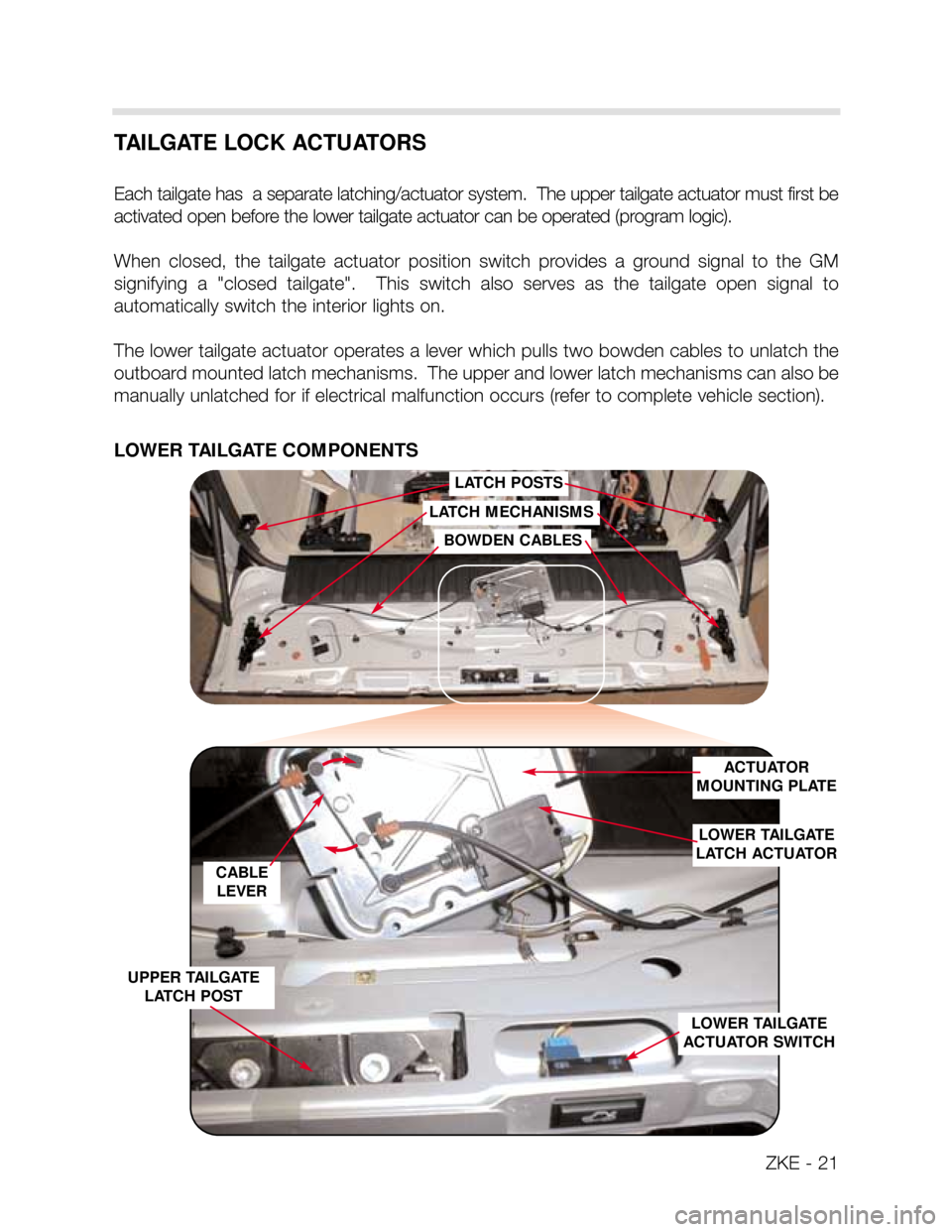
ZKE - 21
LOWER TAILGATE COMPONENTS
BOWDEN CABLES
LATCH POSTS
LATCH MECHANISMS
LOWER TAILGATE
LATCH ACTUATOR
ACTUATOR
MOUNTING PLATE
LOWER TAILGATE
ACTUATOR SWITCH
UPPER TAILGATE
LATCH POST
CABLE
LEVER
TAILGATE LOCK ACTUATORS
Each tailgate has a separate latching/actuator system. The upper tailgate actuator must first be
activated open before the lower tailgate actuator can be operated (program logic).
When closed, the tailgate actuator position switch provides a ground signal to the GM
signifying a "closed tailgate". This switch also serves as the tailgate open signal to
automatically switch the interior lights on.
The lower tailgate actuator operates a lever which pulls two bowden cables to unlatch the
outboard mounted latch mechanisms. The upper and lower latch mechanisms can also be
manually unlatched for if electrical malfunction occurs (refer to complete vehicle section).
Page 22 of 64

ZKE - 22
CENTRAL LOCKING BUTTON
The central lock button in the center console
provides a momentary ground input signal to the
GM.
• This input initiates a single lock for each door
and the trunk.
• The fuel filler flap remains unlocked for
refueling purposes.
• If a door is manually opened while centrally
locked, the remaining doors stay locked.
The opened door can be re-locked when closed by manually locking or pushing the central
button twice. This allows the locks of the remaining doors to be re-synchronized again.
As an additional safety feature, the central lock button input also unlocks a double locked
system. Pressing the button returns the system to central lock (single) position, allowing
the doors to be opened when the interior door handles are opened twice. This feature was
also added to other ZKE systems during the 1999 model year.
CRASH SIGNALLING
The Multiple Restraint System (MRS III) provides a switched signal to the GM in the event
of an accident. The signal is an output function of the MRS control module and becomes
active when MRS determines a crash has occurred.
When active, the GM unlocks the door lock actuators, switches on the interior lights and
signals the LCM III via the K bus to activate the hazard warning flashers.
Once the crash signal is active, the GM will not respond to lock requests from the system
until the ignition switch is cycled or a front door is opened.
Page 43 of 64
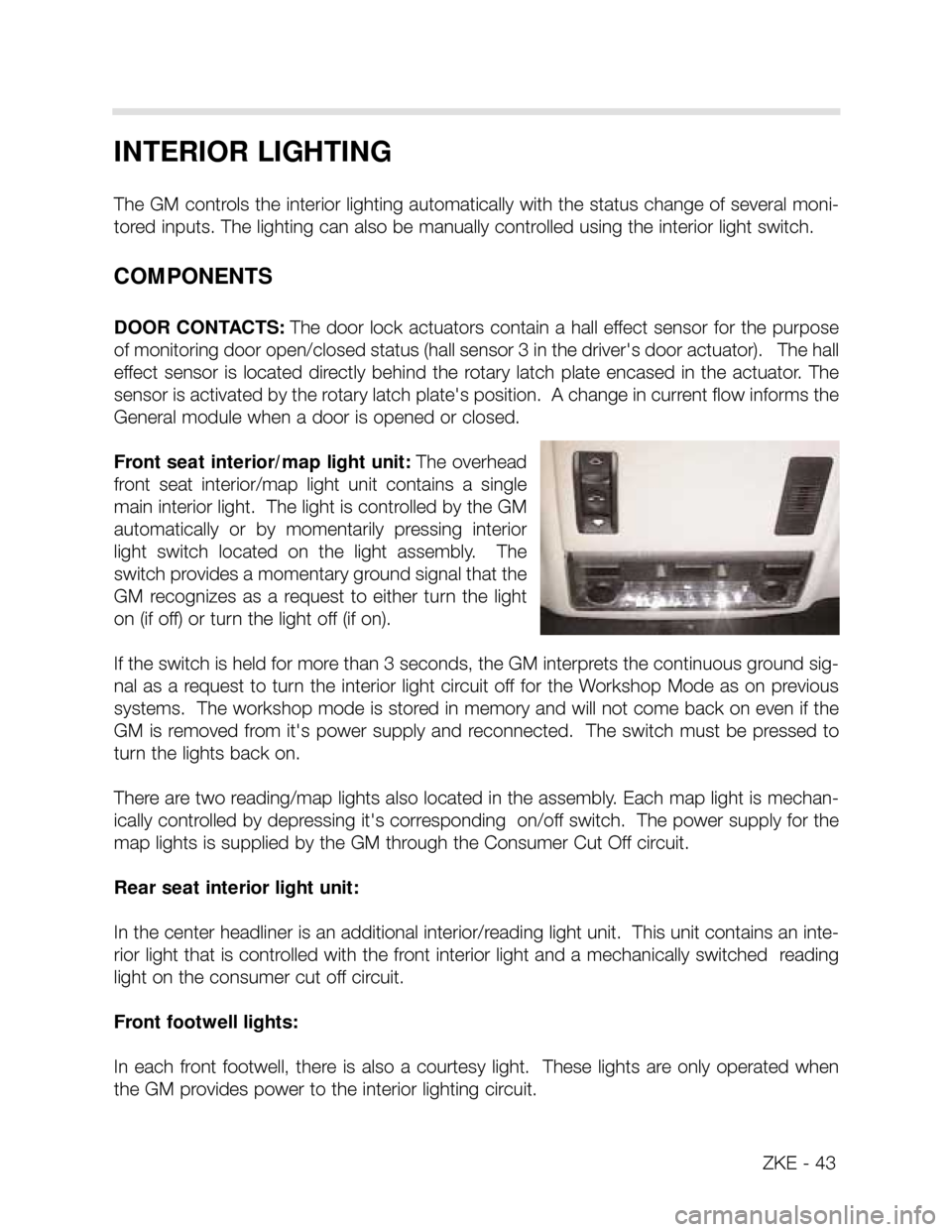
ZKE - 43
INTERIOR LIGHTING
The GM controls the interior lighting automatically with the status change of several moni-
tored inputs. The lighting can also be manually controlled using the interior light switch.
COMPONENTS
DOOR CONTACTS: The door lock actuators contain a hall effect sensor for the purpose
of monitoring door open/closed status (hall sensor 3 in the driver's door actuator). The hall
effect sensor is located directly behind the rotary latch plate encased in the actuator. The
sensor is activated by the rotary latch plate's position. A change in current flow informs the
General module when a door is opened or closed.
Front seat interior/map light unit: The overhead
front seat interior/map light unit contains a single
main interior light. The light is controlled by the GM
automatically or by momentarily pressing interior
light switch located on the light assembly. The
switch provides a momentary ground signal that the
GM recognizes as a request to either turn the light
on (if off) or turn the light off (if on).
If the switch is held for more than 3 seconds, the GM interprets the continuous ground sig-
nal as a request to turn the interior light circuit off for the Workshop Mode as on previous
systems. The workshop mode is stored in memory and will not come back on even if the
GM is removed from it's power supply and reconnected. The switch must be pressed to
turn the lights back on.
There are two reading/map lights also located in the assembly. Each map light is mechan-
ically controlled by depressing it's corresponding on/off switch. The power supply for the
map lights is supplied by the GM through the Consumer Cut Off circuit.
Rear seat interior light unit:
In the center headliner is an additional interior/reading light unit. This unit contains an inte-
rior light that is controlled with the front interior light and a mechanically switched reading
light on the consumer cut off circuit.
Front footwell lights:
In each front footwell, there is also a courtesy light. These lights are only operated when
the GM provides power to the interior lighting circuit.
Page 45 of 64
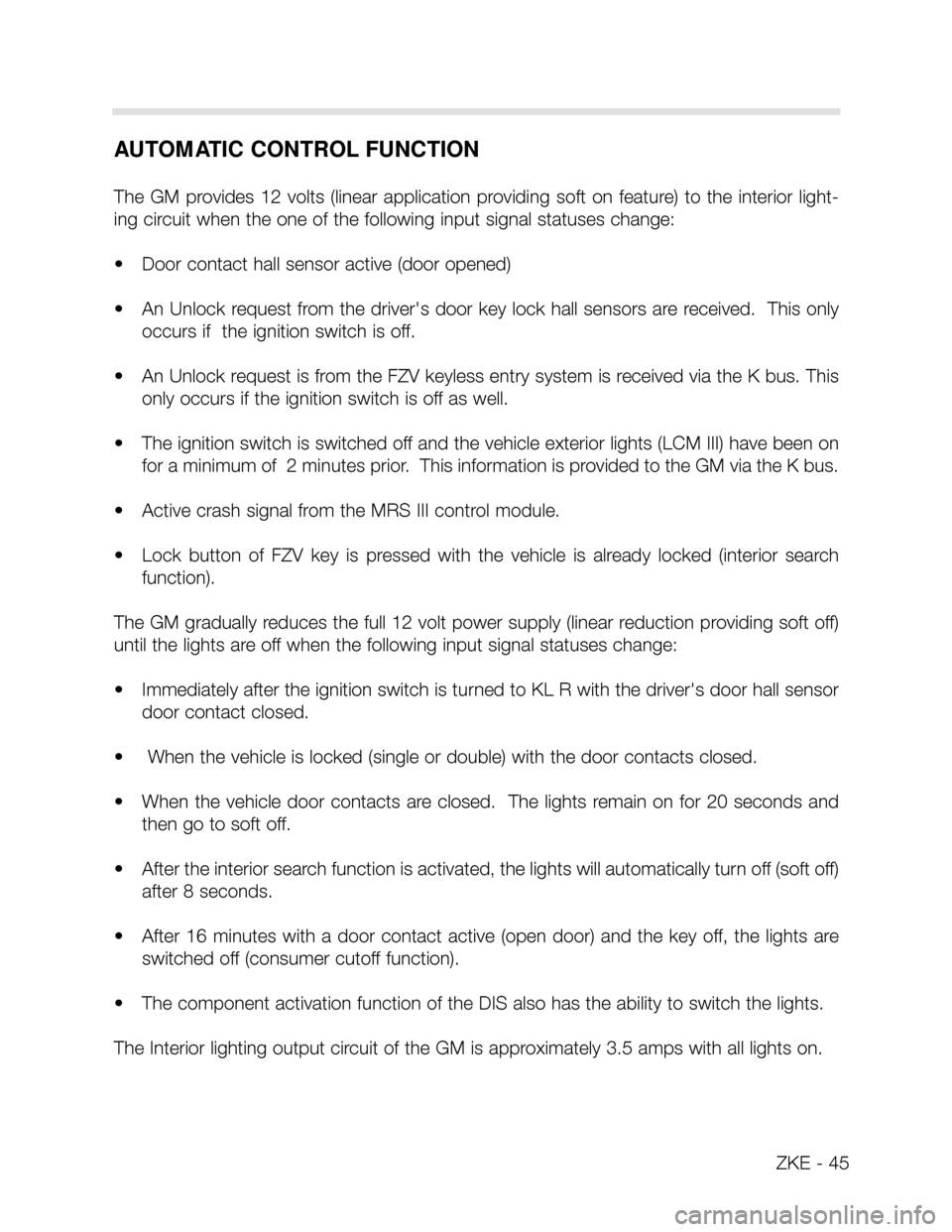
ZKE - 45
AUTOMATIC CONTROL FUNCTION
The GM provides 12 volts (linear application providing soft on feature) to the interior light-
ing circuit when the one of the following input signal statuses change:
• Door contact hall sensor active (door opened)
• An Unlock request from the driver's door key lock hall sensors are received. This only
occurs if the ignition switch is off.
• An Unlock request is from the FZV keyless entry system is received via the K bus. This
only occurs if the ignition switch is off as well.
• The ignition switch is switched off and the vehicle exterior lights (LCM III) have been on
for a minimum of 2 minutes prior. This information is provided to the GM via the K bus.
• Active crash signal from the MRS III control module.
• Lock button of FZV key is pressed with the vehicle is already locked (interior search
function).
The GM gradually reduces the full 12 volt power supply (linear reduction providing soft off)
until the lights are off when the following input signal statuses change:
• Immediately after the ignition switch is turned to KL R with the driver's door hall sensor
door contact closed.
• When the vehicle is locked (single or double) with the door contacts closed.
• When the vehicle door contacts are closed. The lights remain on for 20 seconds and
then go to soft off.
• After the interior search function is activated, the lights will automatically turn off (soft off)
after 8 seconds.
• After 16 minutes with a door contact active (open door) and the key off, the lights are
switched off (consumer cutoff function).
• The component activation function of the DIS also has the ability to switch the lights.
The Interior lighting output circuit of the GM is approximately 3.5 amps with all lights on.
Page 51 of 64
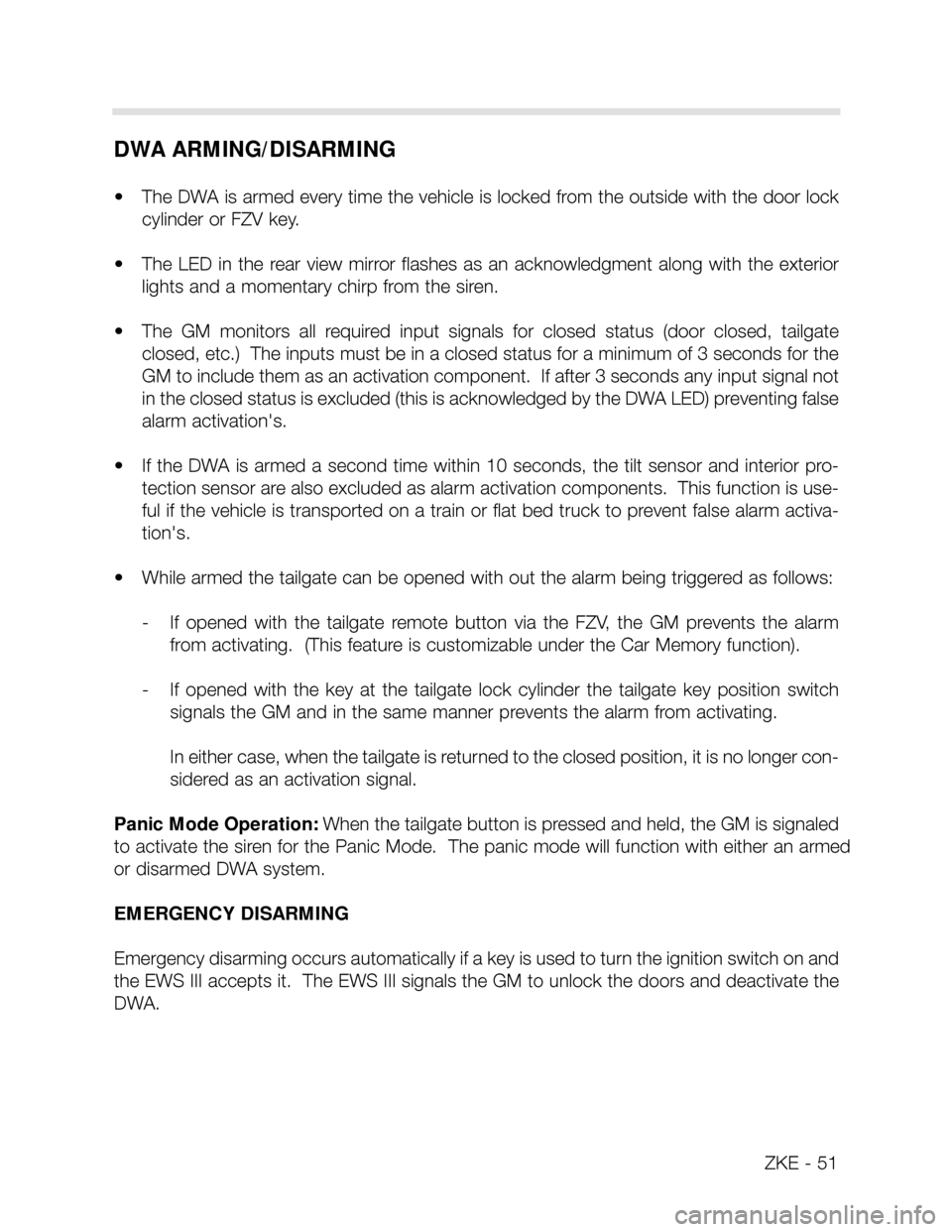
ZKE - 51
DWA ARMING/DISARMING
• The DWA is armed every time the vehicle is locked from the outside with the door lock
cylinder or FZV key.
• The LED in the rear view mirror flashes as an acknowledgment along with the exterior
lights and a momentary chirp from the siren.
• The GM monitors all required input signals for closed status (door closed, tailgate
closed, etc.) The inputs must be in a closed status for a minimum of 3 seconds for the
GM to include them as an activation component. If after 3 seconds any input signal not
in the closed status is excluded (this is acknowledged by the DWA LED) preventing false
alarm activation's.
• If the DWA is armed a second time within 10 seconds, the tilt sensor and interior pro-
tection sensor are also excluded as alarm activation components. This function is use-
ful if the vehicle is transported on a train or flat bed truck to prevent false alarm activa-
tion's.
• While armed the tailgate can be opened with out the alarm being triggered as follows:
- If opened with the tailgate remote button via the FZV, the GM prevents the alarm
from activating. (This feature is customizable under the Car Memory function).
- If opened with the key at the tailgate lock cylinder the tailgate key position switch
signals the GM and in the same manner prevents the alarm from activating.
In either case, when the tailgate is returned to the closed position, it is no longer con-
sidered as an activation signal.
Panic Mode Operation: When the tailgate button is pressed and held, the GM is signaled
to activate the siren for the Panic Mode. The panic mode will function with either an armed
or disarmed DWA system.
EMERGENCY DISARMING
Emergency disarming occurs automatically if a key is used to turn the ignition switch on and
the EWS III accepts it. The EWS III signals the GM to unlock the doors and deactivate the
DWA.
Page 61 of 64
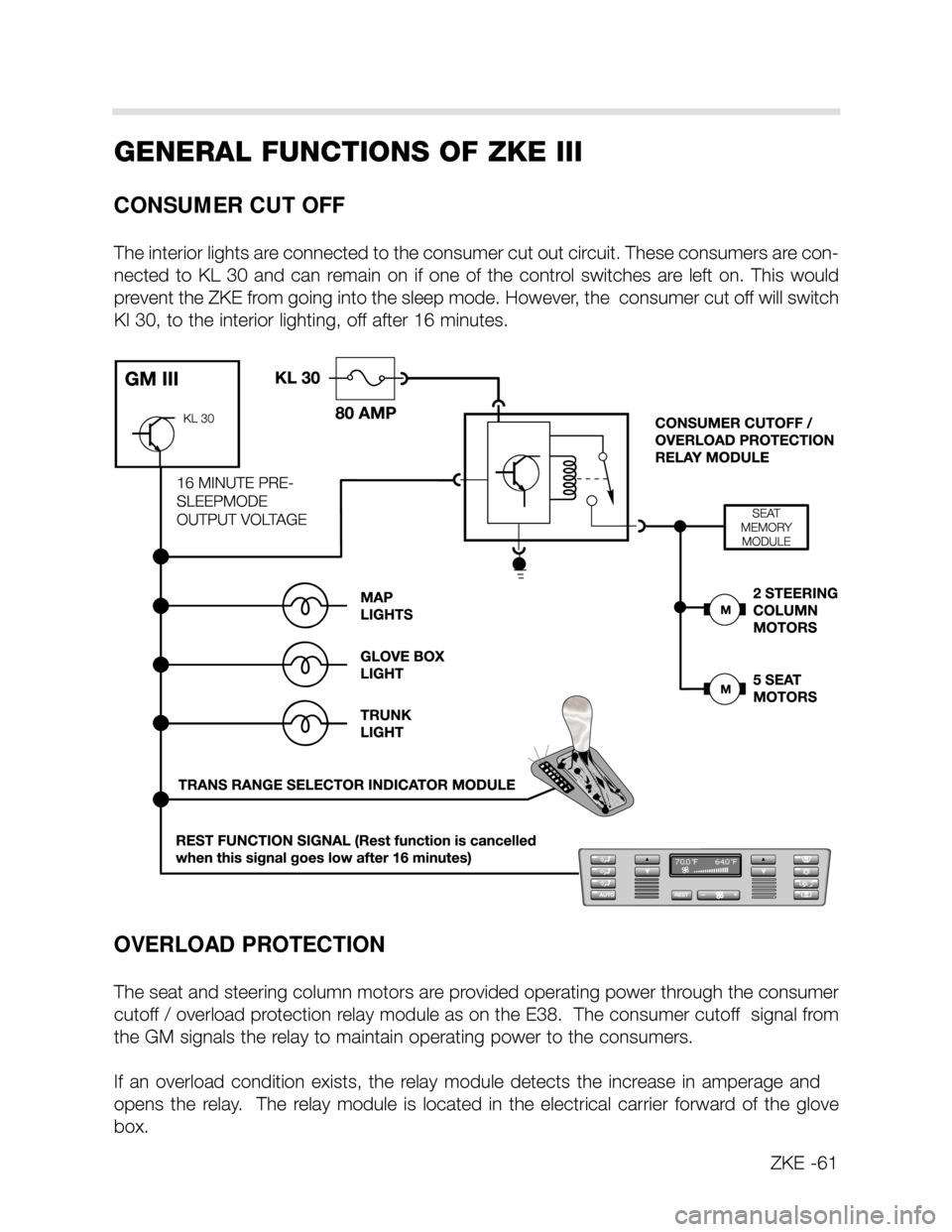
GENERAL FUNCTIONS OF ZKE III
CONSUMER CUT OFF
The interior lights are connected to the consumer cut out circuit. These consumers are con-
nected to KL 30 and can remain on if one of the control switches are left on. This would
prevent the ZKE from going into the sleep mode. However, the consumer cut off will switch
Kl 30, to the interior lighting, off after 16 minutes.
OVERLOAD PROTECTION
The seat and steering column motors are provided operating power through the consumer
cutoff / overload protection relay module as on the E38. The consumer cutoff signal from
the GM signals the relay to maintain operating power to the consumers.
If an overload condition exists, the relay module detects the increase in amperage and
opens the relay. The relay module is located in the electrical carrier forward of the glove
box.
ZKE -61